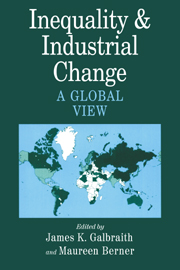Book contents
- Frontmatter
- Contents
- Contributors
- Permissions
- Acknowledgments
- PART I INTRODUCTION TO THEORY AND METHOD
- PART II INEQUALITY, UNEMPLOYMENT, AND INDUSTRIAL CHANGE
- 3 The American Wage Structure: 1920–1947
- 4 Inequality in American Manufacturing Wages, 1920–1998: A Revised Estimate
- 5 Interindustry Wage Structures: New Evidence from the OECD
- 6 Inequality and Unemployment in Europe: The American Cure
- PART III INEQUALITY AND DEVELOPMENT
- PART IV METHODS AND TECHNIQUES
- Data Appendix
- References and Selected Bibliography
- Index
4 - Inequality in American Manufacturing Wages, 1920–1998: A Revised Estimate
Published online by Cambridge University Press: 05 June 2012
- Frontmatter
- Contents
- Contributors
- Permissions
- Acknowledgments
- PART I INTRODUCTION TO THEORY AND METHOD
- PART II INEQUALITY, UNEMPLOYMENT, AND INDUSTRIAL CHANGE
- 3 The American Wage Structure: 1920–1947
- 4 Inequality in American Manufacturing Wages, 1920–1998: A Revised Estimate
- 5 Interindustry Wage Structures: New Evidence from the OECD
- 6 Inequality and Unemployment in Europe: The American Cure
- PART III INEQUALITY AND DEVELOPMENT
- PART IV METHODS AND TECHNIQUES
- Data Appendix
- References and Selected Bibliography
- Index
Summary
Using a monthly data set for wages and employment of production workers in eighteen sectors for which continuous data are available back to January 1947, we compute new measures of earnings and wage inequality in U.S. manufacturing. We confirm that there is a close connection between the dispersion of hourly wage rates and unemployment. But we also show that, contrary to general belief and some of our own previous assumptions, in the 1950s manufacturing wage rate inequality rose sharply, reaching the extreme levels of the 1930s. An implication is that inequality in manufacturing hourly wage rates in the late 1970s and 1980s, previously thought to be lower than during the Great Depression, was in fact much higher. The new series also shows that wage rate inequality began declining again in 1994 and has now fallen to just below the peaks of the interwar period. The data are current to the end of 1998.
Introduction
The previous chapter showed how unemployment and inequality were closely related during the interwar and World War II years. Here we extend that analysis to the late 1990s. New, highly detailed data, as well as calculations by Garza-Cantú, permit us to offer continuous monthly series for inequality in U.S. manufacturing wage rates, beginning in January 1947 and up to date as of December 1998. This series tracks Galbraith's measures for the 1958–1992 period closely. It strongly supports the argument that there is a close association between the dispersion of hourly pay rates and unemployment – in effect, that wage rate inequality is a macroeconomic phenomenon.
- Type
- Chapter
- Information
- Inequality and Industrial ChangeA Global View, pp. 79 - 91Publisher: Cambridge University PressPrint publication year: 2001
- 1
- Cited by

